


|
|
|
 ood
moves. Because of its unique structure, it’s constantly expanding and
contracting. And you must cope with this movement in every project you
build. ood
moves. Because of its unique structure, it’s constantly expanding and
contracting. And you must cope with this movement in every project you
build.
|
|
|
MOISTURE CONTENT AND
MOVEMENT
Wood moves as its moisture content
changes. In a tree that’s just been felled, the wood is “green” — sap
fills the cell cavities. This free water (as the sap is sometimes
called) accounts for 72 percent of the total moisture content, although
this percentage may vary from species to species. The remaining 28
percent saturates the wood
fibers in the cell walls. This
bound water in
the fibers causes them to swell, just as a sponge swells when you wet
it.
As the green wood dries, the free water
evaporates first, then the bound water. The wood is dimensionally stable
(it doesn’t shrink or swell noticeably) as it loses free water, but once
it begins to lose bound water, it contracts.
Wood
dries to an average moisture content of between 4 and 11 percent,
depending on the area of the country, but it never really comes to rest!
The amount of bound water in the wood continually changes with the
amount of moisture in the surrounding atmosphere. On the average, wood
gains or loses about 1 percent moisture content for every 5 percent
change in the relative humidity.
|
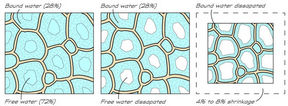
In green wood, free water fills the
cell cavities and bound water saturates the fibers in
the cell walls. As it dries, the free water evaporates first, then the
bound water. The wood doesn’t move until it begins to lose bound water.*
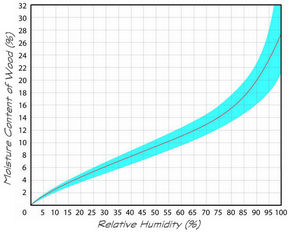
The moisture content
of the wood varies with the relative humidity of the surrounding air, as
this chart shows. Once the wood has been dried, the moisture content
never again rises above 28 percent (its fiber saturation point) from the
effects of humidity alone. For this to happen, the wood must be immersed
in water.*
|

|
|
Humidity -- Wood doesn’t always
move with changes in humidity, just the relative humidity.
The relative humidity is the ratio of the actual moisture in the air
(absolute humidity) to the maximum amount of moisture the air will hold
at its present temperature. The warmer the air, the more moisture it
will hold. Because of this, it’s possible for the absolute humidity to
change while the relative humidity remains the same. If both the
absolute humidity and the air temperature rise at the same time, the
relative humidity will remain constant — and the wood won’t move. |
The wood fibers swell as they absorb moisture and shrink as they release
it, causing the wood to expand and contract. In the Northern Hemisphere,
relative humidity increases in the summer and decreases in the winter.
And due to the effects of heating and air conditioning, the relative
humidity is generally different indoors than out. Additionally, the
relative humidity may vary from one building to another if the indoor
temperatures differ. Consequently, wood tends to move with the seasons
or whenever you change its location.
|
|
|
DIRECTION OF
MOVEMENT
Although
it’s constantly expanding and contracting, wood does not move equally in
all directions. The grain structure causes it to move differently in
three different directions.
-
Wood
is fairly stable along its longitudinal direction, parallel to the
grain. Green lumber shrinks only 0.01 percent of its length as it
dries. An 8-foot-long board will move only 3/32 inch.
-
Wood
moves much more across the grain,
tangent to the growth rings. Green
lumber shrinks as much as 8 percent in this direction.
-
But
it shrinks only half as much (4 percent) in the
radial direction,
extending out from the pith along the radius of the growth rings.
For this reason,
quartersawn lumber
is more stable than
plain-sawn lumber.
Quartersawn lumber is cut radially and moves only half as much
across its width as plain-sawn lumber, which is cut tangentially
|
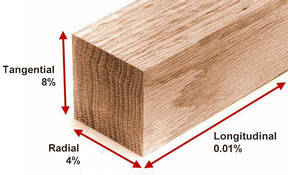
Wood is fairly
stable along its length, moving only 0.01 percent as it loses its bound
water. However, (on the average) it moves 8 percent tangentially and 4
percent radially. |
|
CHANGING SHAPE
The
difference in tangential and radial movement has other important
consequences. Depending on how it’s cut from the tree, a board may
change shape as it dries:
-
If
the annual rings run side to side in square stock, the stock will
shrink to a rectangle.
-
If
the rings run diagonally from corner to corner, the stock will
become diamond-shaped.
-
Round stock becomes oval as the tangential diameter shrinks more
than the radial diameter.
-
Plain-sawn lumber tends to cup in the opposite direction of the
growth rings because the outside face (the face farthest from the
pith) shrinks a little faster than the inside face.
-
In
quartersawn lumber, both faces shrink equally and the board remains
flat.
And there are other
forces that may cause a board to move or change shape. Stress sometimes
develops in the tree as it grows or in the lumber when it’s improperly
dried.
Internally stressed wood (called reaction wood) moves when you cut it.
Cutting relieves some of the stress, and the wood reacts by changing
shape. This is quite different from normal wood movement, however. Once
the stress dissipates, it
no longer affects the wood. But there’s nothing
you can do to stop radial and tangential movement. As long as there’s
weather, the boards will continue to shrink and swell.
|
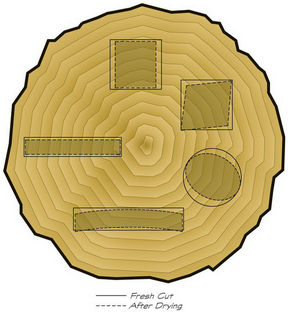
Because of the
difference in tangential and radial movement, boards change shape as
they expand and contract. The way in which they change depends on how
they are cut from the tree.* |
|
ESTIMATING WOOD
MOVEMENT
It’s
also useful to know how much a board is likely to move. You must
anticipate the movement when fitting drawers and doors, inserting panels
in frames, and dozens of other operations.
The rule of thumb is that if the board
shows mostly flat grain on its face, allow for 1⁄4 inch total wood
movement for every 12 inches across the grain. If it shows mostly
quarter grain, allow for 1⁄8 inch movement. This will accommodate an
annual change of 8 percent moisture content — much more than is common
in most areas.
Also consider the time of year. Wood
shrinks to its smallest dimension in the winter and swells to its
maximum in the summer. The wood in winter projects will expand; the wood
in summer projects will contract. In the spring and fall, remember that
the wood will expand half your total movement allowance and contract the
other half. |
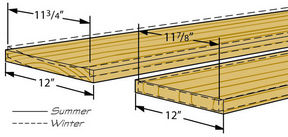
Quartersawn lumber
is more stable than plain-sawn, expanding only half as much across its
width. Additionally, quartersawn boards remain relatively flat, while
plain-sawn boards tend to cup when they expand and contract.* |
|

Back to the top
*Indicates that you
can enlarge a photo by clicking on it. To reveal the information in a "Superphoto,"
first enlarge it and then move the cursor over it. |
|
   |
|